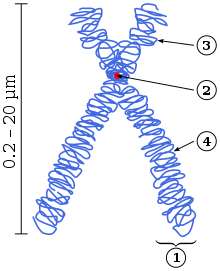
Back Chromatied Afrikaans كروماتيد Arabic Xromatid Azerbaijani ক্রোমাটিড Bengali/Bangla Cromàtide Catalan Chromatida Czech Kromatid Danish Chromatid German Χρωματίδα Greek Chromatid English

(1) Chromatid – one of the two parts of the chromosome after duplication.
(2) Centromere – the point where the two chromatids touch.
(3) Short arm. (4) Long arm.
Chromatids are the daughter strands of a duplicated chromosome which are joined by a single centromere. When the centromere divides, the chromatids become separate chromosomes.[1]
Each of the two daughter chromatids contains the same DNA and chromatin protein as its original chromosome. But in meiosis, crossing over (exchanges) take place between two of the non-sister chromatids. This has profound consequences: it produces genetic recombination, and increases the variability of gametes.
- ↑ King R.C. Stansfield W.D. & Mulligan P.K. 2006. A dictionary of genetics, 7th ed. Oxford. p79